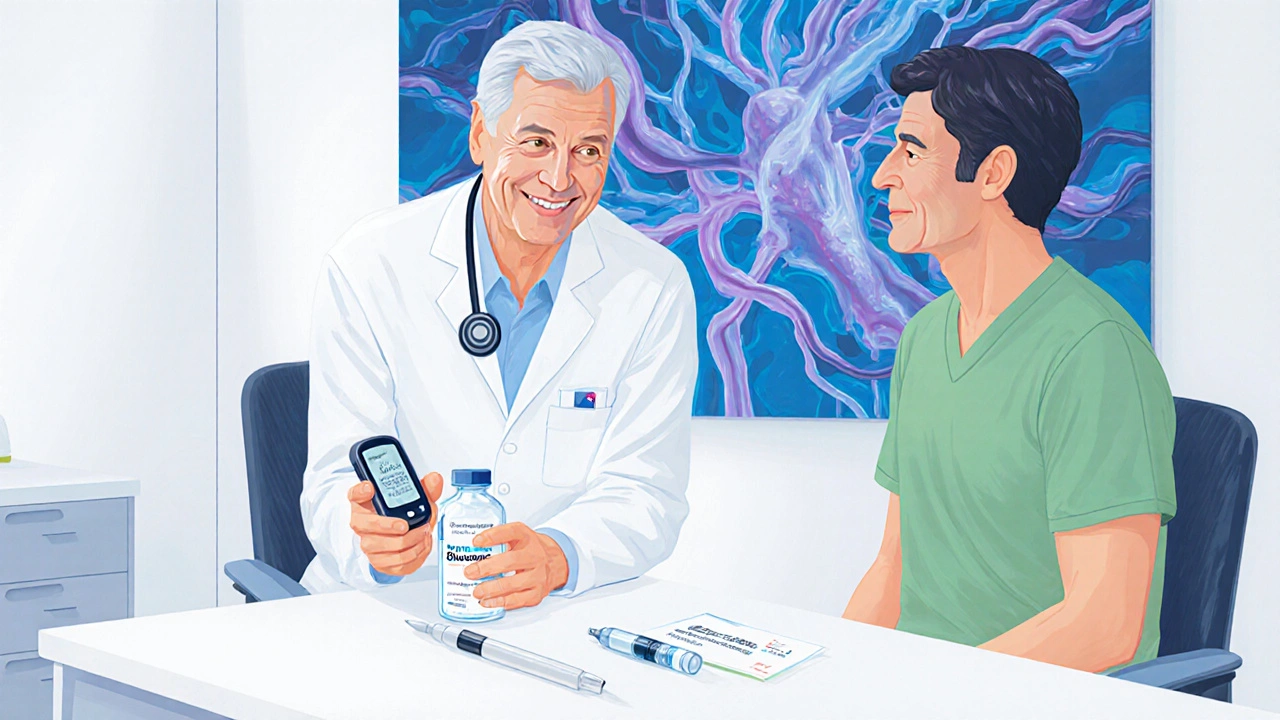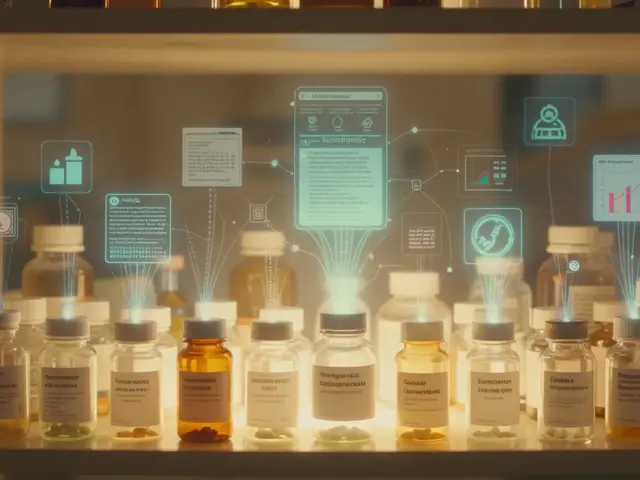Diabetes Medication Comparison Tool
Select your current medication and see how it compares to modern alternatives:
Glucovance is a fixed‑dose combination tablet that pairs Metformin and Glibenclamide to lower blood glucose in adults with type 2 diabetes. It was introduced in the early 2000s to simplify regimens that required two separate pills, offering a single‑tablet solution for patients who need both a biguanide and a sulfonylurea.
Why compare Glucovance with newer options?
Most clinicians now have a broader toolbox. Since Glucovance’s debut, several drug classes-DPP‑4 inhibitors, SGLT2 inhibitors, and GLP‑1 receptor agonists-have demonstrated comparable or better HbA1c reductions with lower hypoglycemia risk. Understanding where Glucovance fits helps doctors, pharmacists, and patients pick a regimen that matches health goals, kidney function, and cost constraints.
Key attributes of the two components
Metformin is a biguanide that primarily reduces hepatic glucose production and improves peripheral insulin sensitivity. Typical doses range from 500mg to 2000mg daily, and it is considered first‑line therapy by most guidelines because it lowers HbA1c by 1‑2% without causing hypoglycemia.
Glibenclamide (also called glyburide) belongs to the sulfonylurea class, stimulating pancreatic β‑cells to release insulin. Doses usually start at 2.5mg once daily and can be titrated to 20mg. While effective at dropping HbA1c 1‑1.5%, it carries a notable risk of hypoglycemia, especially in elderly or renally impaired patients.
Modern alternatives at a glance
Below are the most frequently considered substitutes for the Glucovance combo. Each offers a distinct mechanism, efficacy profile, and safety consideration.
| Drug / Combination | Class | Typical HbA1c reduction | Hypoglycemia risk | Renal dosing limits | Average monthly cost (USD) |
|---|---|---|---|---|---|
| Glucovance (Metformin + Glibenclamide) | Biguanide + Sulfonylurea | ~1.5‑2.0% | Moderate‑High | Metformin: eGFR ≥30mL/min; Glibenclamide: avoid <60mL/min | $30‑$45 |
| Metformin + Glipizide | Biguanide + Sulfonylurea | ~1.6‑2.1% | Moderate | Similar to Glib. | $35‑$50 |
| Metformin + Sitagliptin | Biguanide + DPP‑4 inhibitor | ~0.8‑1.0% | Low | Safe down to eGFR 30mL/min (dose reduction) | $150‑$200 |
| Metformin + Empagliflozin | Biguanide + SGLT2 inhibitor | ~0.9‑1.2% | Low | Not recommended | $200‑$250 |
|
| Metformin + Liraglutide | Biguanide + GLP‑1 receptor agonist | ~1.0‑1.5% | Very low | Safe with eGFR ≥30mL/min | $350‑$450 |
When Glucovance still makes sense
Even with pricier, low‑hypoglycemia options, Glucovance can be attractive in three scenarios:
- Cost‑sensitive patients: For many insurance plans, a generic combination costs less than two separate branded agents.
- Rapid glucose lowering needed: The sulfonylurea component provides a quick insulin surge, useful when baseline HbA1c is >9% and immediate control is required.
- Limited formulary options: Some public drug plans only cover metformin and a sulfonylurea, making the fixed‑dose combo the only covered choice.
In these cases, clinicians should still monitor for hypoglycemia, especially after meals or in patients over 70.

How newer agents address Glucovance’s drawbacks
Sitagliptin is a DPP‑4 inhibitor that enhances endogenous GLP‑1, leading to glucose‑dependent insulin release. Because its action fades when blood sugar is normal, the hypoglycemia risk is minimal. However, the HbA1c drop is modest, so many prescribers pair it with metformin rather than a sulfonylurea.
Empagliflozin blocks SGLT2 in the kidney, causing glucose excretion in urine. Besides glycemic control, it offers cardiovascular and renal protection-benefits Glucovance lacks. The main caution is genital infections and the need for adequate renal function.
Liraglutide mimics GLP‑1, improving insulin secretion, suppressing glucagon, and slowing gastric emptying. It also promotes modest weight loss, a frequent goal for type‑2 diabetics. The downside is injection‑required administration and higher price.
Practical decision‑making framework
Use the following three‑step checklist when you’re unsure whether to stay on Glucovance or switch:
- Assess safety profile: Check eGFR, age, and history of hypoglycemia. If eGFR <45mL/min or the patient is >75y, favor a low‑hypoglycemia agent.
- Evaluate cost vs. benefit: Compare out‑of‑pocket expenses. For patients on a limited budget, calculate monthly savings of Glucovance versus the added cardiovascular benefit of an SGLT2 inhibitor.
- Align with patient goals: If weight loss or cardiovascular risk reduction is a priority, consider a GLP‑1 or SGLT2 combo. If the sole aim is to bring HbA1c under 7% quickly, Glucovance remains a viable short‑term bridge.
Related concepts you’ll encounter
Understanding Glucovance’s place in therapy often leads to discussions about:
- HbA1c target thresholds (typically <7% for most adults, <6.5% for high‑risk patients).
- Renal dosing guidelines for metformin and sulfonylureas, especially after acute kidney injury.
- Cardiovascular outcome trials (e.g., EMPA‑REG, LEADER) that have reshaped prescribing habits toward SGLT2 and GLP‑1 agents.
- Medication adherence strategies, such as fixed‑dose combos versus multiple pills.
These topics form a wider knowledge cluster that readers often explore after evaluating drug choices.
Bottom line
If you need a low‑cost, easy‑to‑take option and can tolerate occasional hypoglycemia, Glucovance still holds value. For patients with renal impairment, cardiovascular disease, or a desire to avoid low blood sugar, newer agents-especially SGLT2 inhibitors and GLP‑1 agonists-offer better safety and added health benefits, albeit at a higher price.Glucovance alternatives therefore should be chosen based on a blend of clinical evidence, patient preferences, and economic realities.
Frequently Asked Questions
What is the main advantage of a fixed‑dose combination like Glucovance?
It reduces pill burden, which can improve adherence, and often costs less than buying the two components separately.
Is Glucovance safe for people with mild kidney disease?
Metformin is generally safe down to an eGFR of 30mL/min, but glibenclamide should be avoided when eGFR falls below 60mL/min because hypoglycemia risk rises sharply. In such cases, switching to a metformin‑DPP‑4 combo is often recommended.
How does the HbA1c reduction of Glucovance compare to metformin‑sitagliptin?
Glucovance typically lowers HbA1c by 1.5‑2%, whereas metformin‑sitagliptin usually achieves a 0.8‑1% reduction. The sulfonylurea component drives the bigger drop but also raises hypoglycemia potential.
Why are newer agents more expensive?
They are patented, involve newer technology, and have demonstrated additional benefits such as cardiovascular protection, which justify higher price points and often better insurance coverage.
Can I switch from Glucovance to a metformin‑GLP‑1 combo without a washout period?
Yes. Because both contain metformin, you can stop the sulfonylurea component and start the GLP‑1 agonist. Monitoring blood glucose for 1‑2 weeks is advised to avoid unexpected lows.
What lifestyle changes enhance the effectiveness of any diabetes medication?
Consistent carbohydrate counting, regular aerobic exercise (150min/week), weight management, and adequate sleep all amplify drug efficacy and can reduce the needed dose.
Is hypoglycemia a concern with SGLT2 inhibitors?
SGLT2 inhibitors have a low intrinsic risk of hypoglycemia because they work independently of insulin. However, if combined with a sulfonylurea or insulin, the risk can rise.







Comments
Brian Koehler
27 September 2025From a cost‑effectiveness standpoint, Glucovance presents a compelling proposition: a single tablet that merges Metformin’s proven glucose‐lowering capacity with Glibenclamide’s insulin‑secretagogue action, all while remaining markedly affordable; however, clinicians must balance this financial advantage against the elevated hypoglycemia risk inherent to sulfonylureas, especially in patients with compromised renal function, and remain vigilant about dose adjustments.
Dominique Lemieux
28 September 2025While many celebrate the advent of SGLT2 inhibitors and GLP‑1 agonists as heralds of a new era, one must not overlook the pragmatic virtues that older combinations such as Glucovance still retain; the blend of Metformin and Glibenclamide, after all, has been honed through decades of clinical experience, offering a predictable pharmacodynamic profile that newer agents have yet to fully demonstrate. The cost differential is stark, with Glucovance typically priced under forty dollars per month versus the triple‑digit price tags of Empagliflozin or Semaglutide, a factor that cannot be dismissed in health‑care systems burdened by budget constraints. Moreover, in patients with robust renal function, the Metformin component continues to deliver its hallmark reduction in hepatic gluconeogenesis without the need for complex dose titration. Yet, the sulfonylurea element inevitably introduces a moderate‑to‑high hypoglycemia risk, a trade‑off that demands careful patient selection, especially among the elderly or those with erratic meal patterns. Critics may argue that the risk profile alone renders Glucovance obsolete; however, the evidence suggests that when paired with diligent monitoring, the combination can achieve HbA1c reductions comparable to many newer agents. It is also noteworthy that the fixed‑dose formulation simplifies adherence, reducing pill burden-a non‑trivial consideration for individuals managing polypharmacy. Nonetheless, one should remain wary of the cardiovascular outcomes data that increasingly favor SGLT2 inhibitors, which have demonstrated mortality benefits beyond glycemic control. In contrast, sulfonylureas have, in some large trials, been linked to modestly higher rates of adverse cardiovascular events, a nuance that must inform shared decision‑making. The renal dosing constraints of Metformin-necessitating an eGFR of at least 30 mL/min-further limit its applicability in patients with chronic kidney disease, whereas many modern agents possess more forgiving renal thresholds. Additionally, the gastrointestinal side effects of Metformin, while often transient, can impair tolerability for some patients, prompting the need for dose escalation strategies. From a pharmacoeconomic perspective, the simplicity of a single tablet reduces pharmacy dispensing costs and may improve medication possession ratios. Yet, the looming specter of hypoglycemia may engender additional healthcare utilization, offsetting some of those savings. In the end, the decision to employ Glucovance versus a newer alternative must be individualized, weighing cost, renal function, cardiovascular risk, and patient preferences in concert. Ultimately, the therapeutic landscape is richer for offering both legacy and novel options, each with its own set of trade‑offs that demand nuanced clinical judgment.
Laura MacEachern
29 September 2025Great summary, very encouraging!
BJ Anderson
1 October 2025Indeed, the drama of balancing efficacy and safety feels like a high‑stakes chess match; Glucovance’s dual action may be a bold opening, but the opponent-hypoglycemia-can deliver a swift checkmate if the board isn’t carefully surveyed.
Alexander Rodriguez
2 October 2025Glucovance costs around $30 a month and drops HbA1c by about 1.5 % on average, which is solid for its price point.
Abhinav Sharma
3 October 2025When one contemplates the juxtaposition of ancient sulfonylureas with contemporary incretin‑based therapies, the tapestry of diabetes management reveals both continuity and disruption 😊; the old guard offers reliability, while the new heralds innovation, and the optimal path often lies in a harmonious blend of the two.
Welcher Saltsman
4 October 2025True that, but you gotta think about the hypoglycemia risk-it's not just the numbers, it's the real‑life impact on patients.
april wang
5 October 2025From an educational perspective, it is essential to recognize that the decision matrix for selecting a glucose‑lowering regimen extends far beyond mere HbA1c percentages; it incorporates patient lifestyle, comorbid conditions, renal function, cardiovascular risk, and even socioeconomic factors such as drug affordability and insurance coverage. For instance, a patient residing in a rural area with limited access to specialty pharmacies may benefit more from a low‑cost, once‑daily combination like Glucovance, whereas an individual with established heart failure might derive additional mortality benefit from an SGLT2 inhibitor. Moreover, the pharmacodynamic nuances of each class merit careful consideration: Metformin chiefly attenuates hepatic gluconeogenesis, while Glibenclamide directly stimulates insulin secretion, a mechanism that can be advantageous in insulin‑deficient states but precarious in the presence of fluctuating caloric intake. The clinician must also weigh the potential for gastrointestinal upset with Metformin against the genital mycotic infections sometimes observed with SGLT2 inhibitors, and the injectable nature of GLP‑1 agonists against patient aversion to needles. In summary, an individualized, patient‑centered approach-grounded in shared decision‑making and thorough risk‑benefit analysis-is the cornerstone of optimal diabetes care.
Vishnu Raghunath
6 October 2025Oh, sure, because everyone loves a 500‑word essay on drug choices-let’s all bring a thesaurus to the next clinic visit.
Aparna Dheep
8 October 2025Honestly, the whole debate feels a bit overrated when the numbers speak for themselves.